Mathematics 12
- Chapter 1 Relations And Functions
- Chapter 2 Inverse Trigonometric Functions
- Chapter 3 Matrices
- Chapter 4 Determinants
- Chapter 5 Continuity And Differentiability
- Chapter 6 Application Of Derivatives
- Chapter 7 Integrals
- Chapter 8 Application Of Integrals
- Chapter 9 Differential Equations
- Chapter 10 Vector Algebra
- Chapter 11 Three Dimensional Geometry
- Chapter 12 Linear Programming
- Chapter 13 Probability
Chapter 12 Linear Programming
LINEAR PROGRAMMING
The mathematical experience of the student is incomplete if he never had the opportunity to solve a problem invented by himself. - G. POLYA
Introduction
In earlier classes, we have discussed systems of linear equations and their applications in day to day problems. In Class XI, we have studied linear inequalities and systems of linear inequalities in two variables and their solutions by graphical method. Many applications in mathematics involve systems of inequalities/equations. In this chapter, we shall apply the systems of linear inequalities/equations to solve some real life problems of the type as given below:
A furniture dealer deals in only two items-tables and chairs. He has Rs 50,000 to invest and has storage space of at most 60 pieces. A table costs Rs 2500 and a chair Rs 500 . He estimates that from the sale of one table, he can make a profit of Rs 250 and that from the sale of one

L. Kantorovich chair a profit of Rs 75 . He wants to know how many tables and chairs he should buy from the available money so as to maximise his total profit, assuming that he can sell all the items which he buys.
Such type of problems which seek to maximise (or, minimise) profit (or, cost) form a general class of problems called optimisation problems. Thus, an optimisation problem may involve finding maximum profit, minimum cost, or minimum use of resources etc.
A special but a very important class of optimisation problems is linear programming problem. The above stated optimisation problem is an example of linear programming problem. Linear programming problems are of much interest because of their wide applicability in industry, commerce, management science etc.
In this chapter, we shall study some linear programming problems and their solutions by graphical method only, though there are many other methods also to solve such problems.
Linear Programming Problem and its Mathematical Formulation
We begin our discussion with the above example of furniture dealer which will further lead to a mathematical formulation of the problem in two variables. In this example, we observe
(i) The dealer can invest his money in buying tables or chairs or combination thereof. Further he would earn different profits by following different investment strategies.
(ii) There are certain overriding conditions or constraints viz., his investment is limited to a maximum of Rs 50,000 and so is his storage space which is for a maximum of 60 pieces.
Suppose he decides to buy tables only and no chairs, so he can buy
Suppose he chooses to buy chairs only and no tables. With his capital of Rs 50,000, he can buy
There are many other possibilities, for instance, he may choose to buy 10 tables and 50 chairs, as he can store only 60 pieces. Total profit in this case would be Rs
We, thus, find that the dealer can invest his money in different ways and he would earn different profits by following different investment strategies.
Now the problem is: How should he invest his money in order to get maximum profit? To answer this question, let us try to formulate the problem mathematically.
Mathematical formulation of the problem
Let
The dealer is constrained by the maximum amount he can invest (Here it is Rs 50,000 ) and by the maximum number of items he can store (Here it is 60).
Stated mathematically,
or
and
The dealer wants to invest in such a way so as to maximise his profit, say,
Mathematically, the given problems now reduces to:
Maximise
subject to the constraints:
So, we have to maximise the linear function
Thus, a Linear Programming Problem is one that is concerned with finding the optimal value (maximum or minimum value) of a linear function (called objective function) of several variables (say
Before we proceed further, we now formally define some terms (which have been used above) which we shall be using in the linear programming problems:
Objective function Linear function
In the above example,
Constraints The linear inequalities or equations or restrictions on the variables of a linear programming problem are called constraints. The conditions
Optimisation problem A problem which seeks to maximise or minimise a linear function (say of two variables
We will now discuss how to find solutions to a linear programming problem. In this chapter, we will be concerned only with the graphical method.
Graphical method of solving linear programming problems
In Class XI, we have learnt how to graph a system of linear inequalities involving two variables
The graph of this system (shaded region) consists of the points common to all half planes determined by the inequalities (1) to (4) (Fig 12.1). Each point in this region represents a feasible choice open to the dealer for investing in tables and chairs. The region, therefore, is called the feasible region for the problem. Every point of this region is called a feasible solution to the problem. Thus, we have,
Feasible region The common region determined by all the constraints including non-negative constraints
Feasible solutions Points within and on the boundary of the feasible region represent feasible solutions of the constraints. In Fig 12.1, every point within and on the boundary of the feasible region
Any point outside the feasible region is called an infeasible solution. For example, the point
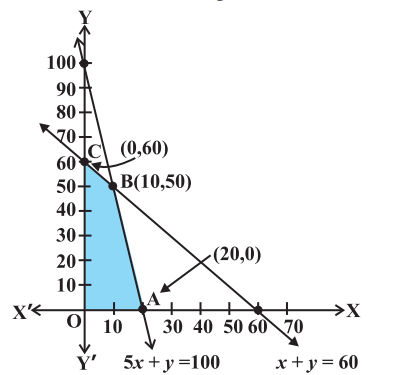
Fig 12.1
Optimal (feasible) solution: Any point in the feasible region that gives the optimal value (maximum or minimum) of the objective function is called an optimal solution.
Now, we see that every point in the feasible region
Theorem 1 Let
Theorem 2 Let
Remark If
In the above example, the corner points (vertices) of the bounded (feasible) region are:
We have
| Vertex of the Feasible region | Correasponding calue of Z (in Rs) |
|---|---|
| O(0,0) | 0 |
| C(0,60) | 4500 |
| B(10,50) | |
| A(20,0) | 5000 |
- A corner point of a feasible region is a point in the region which is the intersection of two boundary lines.
** A feasible region of a system of linear inequalities is said to be bounded if it can be enclosed within a circle. Otherwise, it is called unbounded. Unbounded means that the feasible region does extend indefinitely in any direction.
We observe that the maximum profit to the dealer results from the investment strategy
This method of solving linear programming problem is referred as Corner Point Method. The method comprises of the following steps:
-
Find the feasible region of the linear programming problem and determine its corner points (vertices) either by inspection or by solving the two equations of the lines intersecting at that point.
-
Evaluate the objective function
-
(i) When the feasible region is bounded,
(ii) In case, the feasible region is unbounded, we have:
- (a)
(b) Similarly,
We will now illustrate these steps of Corner Point Method by considering some examples:
Example 1 Solve the following linear programming problem graphically:
Maximise
subject to the constraints:
Solution The shaded region in Fig 12.2 is the feasible region determined by the system of constraints (2) to (4). We observe that the feasible region OABC is bounded. So, we now use Corner Point Method to determine the maximum value of
The coordinates of the corner points
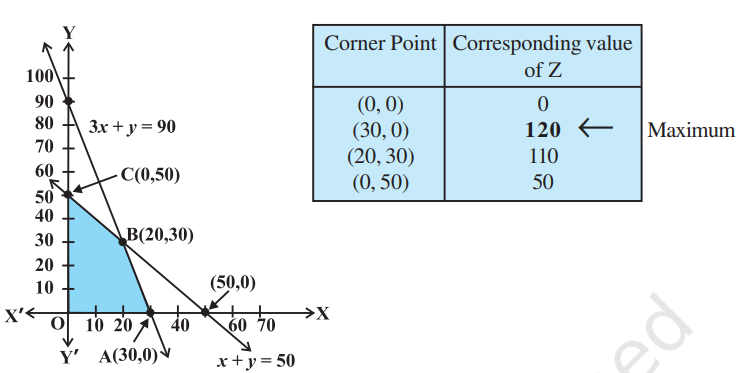
Fig 12.2
Hence, maximum value of
Example 2 Solve the following linear programming problem graphically:
Minimise
subject to the constraints:
Solution The shaded region in Fig 12.3 is the feasible region ABC determined by the system of constraints (2) to (4), which is bounded. The coordinates of corner points
| Corner Point | Corresponding calue |
|---|---|
| (0.5) | 2500 |
| (4,3) | |
| (0,6) | 3000 |
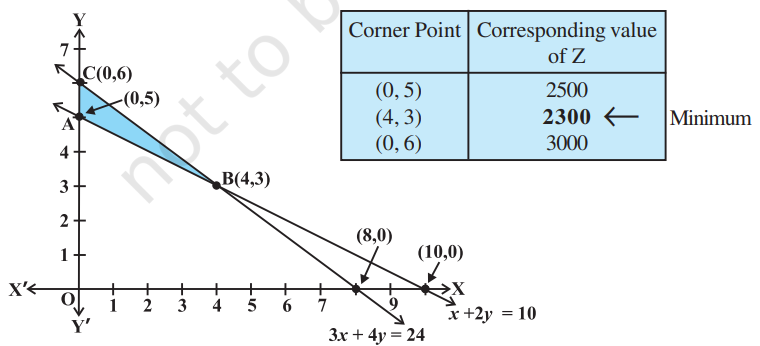
Fig 12.3
A, B and
Hence, minimum value of
Example 3 Solve the following problem graphically:
Minimise and Maximise
subject to the constraints:
Solution First of all, let us graph the feasible region of the system of linear inequalities (2) to (5). The feasible region
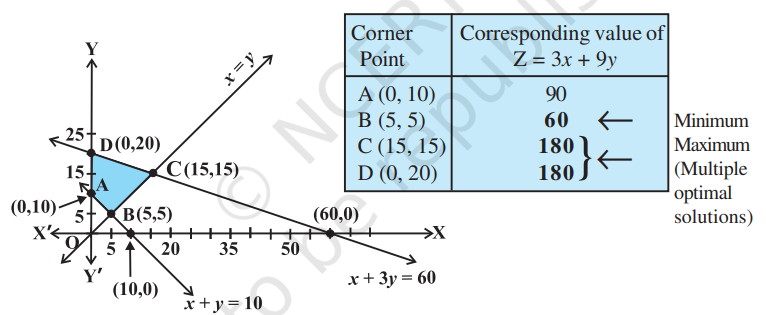
Fig 12.4
We now find the minimum and maximum value of
The maximum value of
Remark Observe that in the above example, the problem has multiple optimal solutions at the corner points
Example 4 Determine graphically the minimum value of the objective function
subject to the constraints:
Solution First of all, let us graph the feasible region of the system of inequalities (2) to (5). The feasible region (shaded) is shown in the Fig 12.5. Observe that the feasible region is unbounded.
We now evaluate

Fig 12.5
From this table, we find that -300 is the smallest value of
i.e.,
and check whether the resulting open half plane has points in common with feasible region or not. If it has common points, then -300 will not be the minimum value of
As shown in the Fig 12.5, it has common points. Therefore,
In the above example, can you say whether
Example 5 Minimise
subject to the constraints:
Solution Let us graph the inequalities (1) to (3) (Fig 12.6). Is there any feasible region? Why is so?
From Fig 12.6, you can see that there is no point satisfying all the constraints simultaneously. Thus, the problem is having no feasible region and hence no feasible solution.
Remarks From the examples which we have discussed so far, we notice some general features of linear programming problems:
(i) The feasible region is always a convex region.
(ii) The maximum (or minimum)
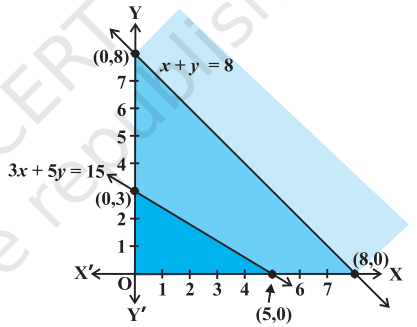
Fig 12.6 solution of the objective function occurs at the vertex (corner) of the feasible region. If two corner points produce the same maximum (or minimum) value of the objective function, then every point on the line segment joining these points will also give the same maximum (or minimum) value.
EXERCISE 12.1
Solve the following Linear Programming Problems graphically:
1. Maximise
subject to the constraints :
Solution
The feasible region determined by the constraints,

The corner points of the feasible region are
| Corner point | ||
|---|---|---|
| 0 | ||
| 12 | ||
| 16 |
Therefore, the maximum value of
2. Minimise
subject to
Solution
The feasible region determined by the system of constraints,

The corner points of the feasible region are
| Corner point | ||
|---|---|---|
| 0 | ||
| -12 | ||
| 6 | ||
| 16 |
Therefore, the minimum value of
3. Maximise
subject to
Solution
The feasible region determined by the system of constraints,

The corner points of the feasible region are
| Corner point | ||
|---|---|---|
| 0 | ||
| 10 | ||
| 9 | ||
4. Minimise
such that
Solution
The feasible region determined by the system of constraints,

It can be seen that the feasible region is unbounded.
The corner points of the feasible region are
The values of
| Corner point | ||
|---|---|---|
| 9 | ||
| 7 | ||
| 10 |
As the feasible region is unbounded, therefore, 7 may or may not be the minimum value of
For this, we draw the graph of the inequality,
It can be seen that the feasible region has no common point with
the minimum value of
5. Maximise
subject to
Solution
The feasible region determined by the constraints,

The corner points of the feasible region are
The values of
| Corner point | ||
|---|---|---|
| 15 | ||
| 18 | ||
| 10 |
Therefore, the maximum value of
6. Minimise
subject to
Show that the minimum of
Solution
The feasible region determined by the constraints,

The corner points of the feasible region are
The values of
| Corner point | |
|---|---|
| 6 | |
| 6 |
It can be seen that the value of
Thus, the minimum value of
Therefore, the value of
7. Minimise and Maximise
subject to
Solution
The feasible region determined by the constraints,

The corner points of the feasible region are
The values of
| Corner point | ||
|---|---|---|
| 300 | ||
| 600 | ||
| 600 | ||
| 400 |
The minimum value of
8. Minimise and Maximise
subject to
Solution
The feasible region determined by the constraints,

The corner points of the feasible region are
The values of
| Corner point | ||
|---|---|---|
| 100 | ||
| 100 | ||
| 250 | ||
| 400 |
The maximum value of
9. Maximise
Solution
The feasible region determined by the constraints,

It can be seen that the feasible region is unbounded.
The values of
| Corner point | |
|---|---|
As the feasible region is unbounded, therefore,
For this, we graph the inequality,
The resulting feasible region has points in common with the feasible region.
Therefore,
10. Maximise
Solution
The region determined by the constraints,

There is no feasible region and thus,
Summary
A linear programming problem is one that is concerned with finding the optimal value (maximum or minimum) of a linear function of several variables (called objective function) subject to the conditions that the variables are non-negative and satisfy a set of linear inequalities (called linear constraints). Variables are sometimes called decision variables and are non-negative.
Historical Note
In the World War II, when the war operations had to be planned to economise expenditure, maximise damage to the enemy, linear programming problems came to the forefront.
The first problem in linear programming was formulated in 1941 by the Russian mathematician, L. Kantorovich and the American economist, F. L. Hitchcock, both of whom worked at it independently of each other. This was the well known transportation problem. In 1945, an English economist, G.Stigler, described yet another linear programming problem - that of determining an optimal diet.
In 1947, the American economist, G. B. Dantzig suggested an efficient method known as the simplex method which is an iterative procedure to solve any linear programming problem in a finite number of steps.
L. Katorovich and American mathematical economist, T. C. Koopmans were awarded the nobel prize in the year 1975 in economics for their pioneering work in linear programming. With the advent of computers and the necessary softwares, it has become possible to apply linear programming model to increasingly complex problems in many areas.






